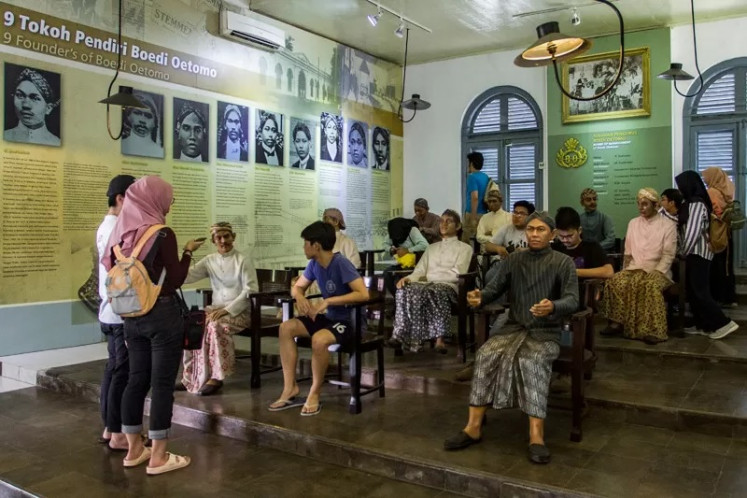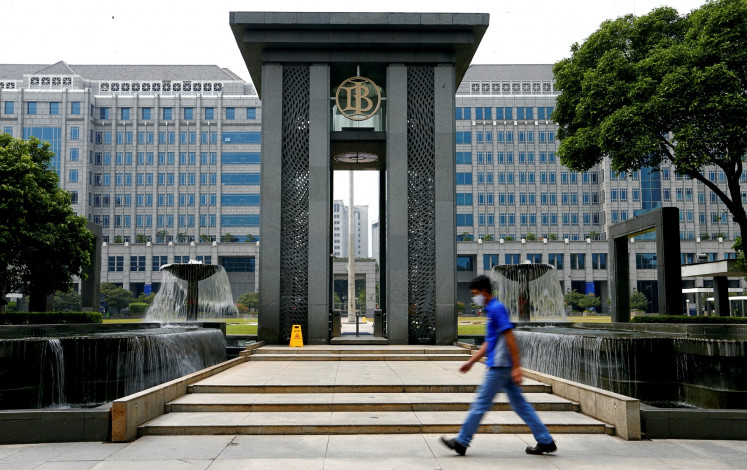Palm sugar: The secret ingredient
Do you remember the first time you ate palm sugar? Perhaps it was drizzled onto warm banana pancakes topped with grated coconut or mixed into the ubiquitous black rice pudding
Change text size
Gift Premium Articles
to Anyone

Do you remember the first time you ate palm sugar? Perhaps it was drizzled onto warm banana pancakes topped with grated coconut or mixed into the ubiquitous black rice pudding.
Palm sugar is one of Bali's best kept secrets. Desserts drenched in this golden sugar form an indelible taste memory and one that is part of the authentic Bali experience.
I have a deep fondness for the local produce of Bali -- from fat red chilies to candlenut, soft tamarind, nutmeg, cloves, sea salt and, of course, palm sugar.
In a land that survives on cottage industries, I find the home-grown feel of all that we eat such a joy.
Palm sugar is the celebrated nectar of the Gods and is made in coconut groves around Bali. Its production is one of those labor-of-love home industries that requires athletic dedication for very little reward.
It has a high nutritional value and contains thiamine, riboflavin, nicotinic acid, ascorbic acid and minerals such as calcium, phosphorous and iron.
When it comes to flavor, there is nothing like it. I guess you could call it heaven in a cone, or even something more sensual, as the shape resembles that voluptuous part of a woman's torso (rather like Sophia Loren in her younger days, if you know what I mean).
Palm sugar is gently sweet and surprisingly complex in flavor with a lovely fudge-like texture and a color that glows like sunburnt toffee or polished Balinese skin.
One of the earliest forms of crystallized sugar known to humanity, palm sugar is procured from the nectar of the cut flower stalk of the coconut palm.
The liquid is then boiled down to a thick toffee-like consistency and poured into coconut shells so it emerges as large hemispheres of unrefined sugar.
Palm sugar is known as gur in India, jaggery in Sri Lanka and Burma, gula melaka in Malaysia and gula jawa or gula merah in Indonesia. By a singular provision of nature, the same nectar that produces palm sugar also produces tuak, or local alcohol.
When I need to stock the bamboo cupboards with this local treat, I take the long drive to East Bali to the home of Bapak Nengah -- past picture-perfect rice fields, faded old warungs and antique-looking compounds.
Sapodilla, cocoa and coffee trees line the road on the way to his house in a tangled frenzy and village life hums at a gentle pace.
Driving through each sleepy town, we pass school children, mothers working in temples and farmers squatting by the roadside, smoothing the feathers of their fighting roosters, oblivious to the passing traffic.
When I'm on a mission to find palm sugar, that ambrosial ingredient that tempers the hottest curry and balances a thousand spices, I'll drive to the end of the earth to find it!
Our journey finishes in a secret cul-de-sac on the edge of a hill near Klungkung, at the home of Bapak Nengah. Whenever I visit, he is there to greet me at the entrance of his small, neat compound that sparkles under the kind shade of mango trees, Himalayan magnolia and coconut palms.
There is a wild, undiscovered feeling about this remote hideaway where tourists rarely visit. At times it feels a little eerie.
Bapak Nengah has been making palm sugar as long as he can remember, as has his father and on it goes. A government worker during the day, he collects the coconut-scented nectar first thing in the morning and late afternoon when he comes home.
His well-shaped calf muscles are a testimony of his hard work. His mother and wife complete the task while he is at the office, by boiling the nectar down, pouring it into coconut shells and preparing it for market.
I asked Bapak Nengah if he found it difficult climbing these slender trees twice a day. Let's face it, this is not a job for the faint hearted.
"Oh, no," he replied. "It's easy because I have a ladder!"
Good thinking, I thought.
"May I see it?" I asked inquisitively, admiring his ingenuity.
He took me to his small plantation of smug coconut palms.
"There," he said as he pointed to some shallow notches cut into the trunks of one of the trees. "A ladder."
He then proceeded to tell me how he loves sitting on the highest branches of the palm trees on windy days.
"It's just like a big swing!" he laughed (should have been born one of those bungy-jumping New Zealanders, I thought to myself).
I watched the palm sugar reducing in a huge wok tended by Bapak Nengah's robust mother. There is something so honest and loving about these sorts of village enterprises. The whole process, from start to finish, is one with nature in the purest sense. Preservatives and machinery are not used and just about every part of the process uses coconut in some form. You can't get more organic or unrefined than that.
But there's more to it. The palm tree is environmentally friendly in every sense of the word as it places no strain on Mother Nature. It requires very little water, very little space and sustains the life of those who live in its shadow.
We sampled palm sugar from the wok at halfway point.
"This is my favorite," he claimed dreamily.
It tasted like the finest maple syrup. When it was ready, we ate a generous spoonful on a banana leaf. This time it was like full-bodied warm fudge. My mind trailed off into a culinary dreamworld, thinking of palm sugar with chocolate, cream and coconut milk. In a word, bliss!
When it comes to cooking, palm sugar is what I call the magic ingredient. If your curry has that "something missing" quality or there is a touch of bitterness or too much chili heat, a dash of palm sugar will perform an astonishing balancing act and take it to the next level.
But it doesn't stop with Asian cuisine. I have even included a drizzle of palm sugar in favorite casseroles such as osso bucco, pasta sauces and, of course, cakes. You can even try it in cocktails! Enak banget!
Selamat Makan!
Janet DeNeefe is the owner of Casa Luna and Indus Restaurants, author of Fragrant Rice, and founder and director of the Ubud Writers & Readers Festival. She also runs the Casa Luna Cooking School.









